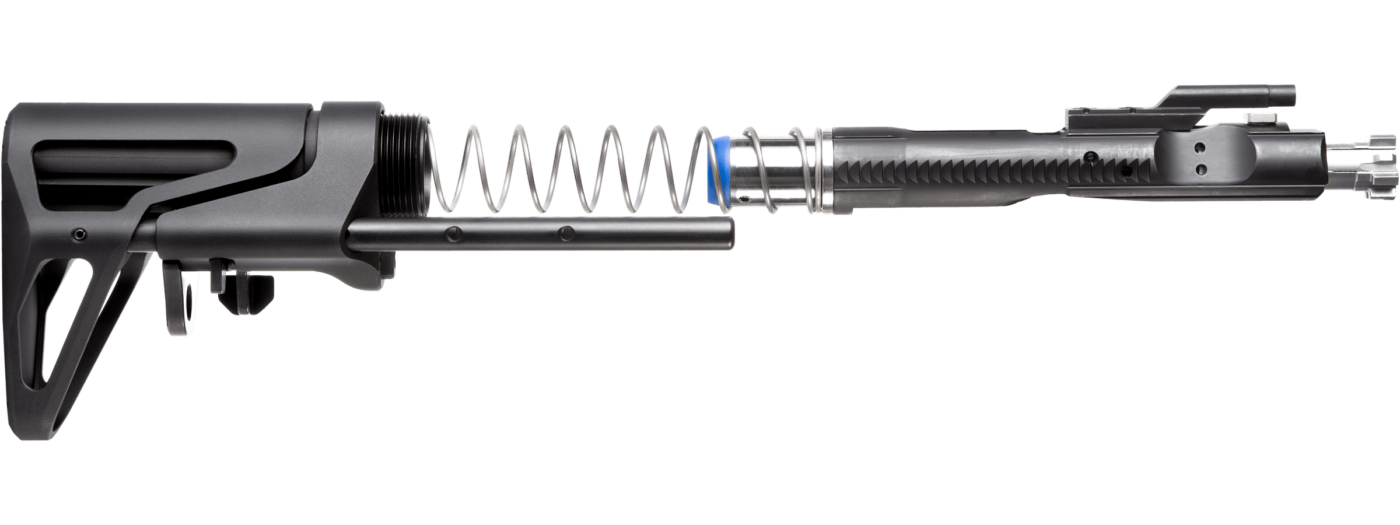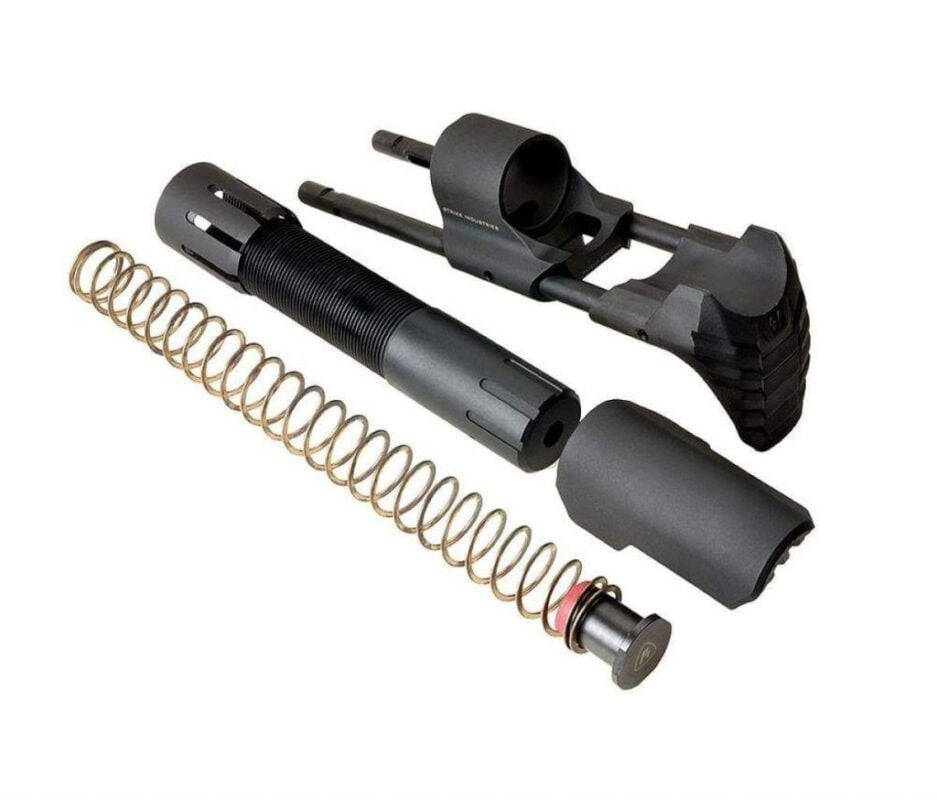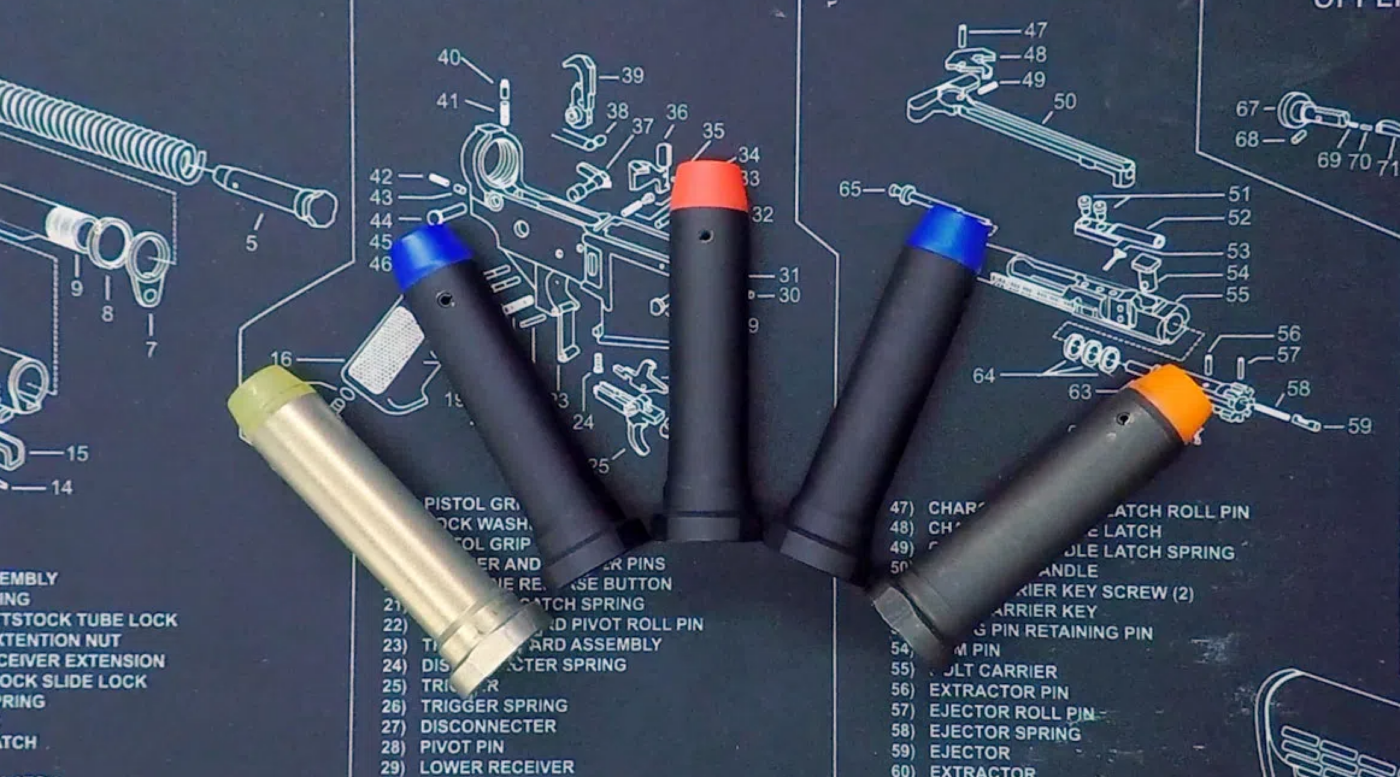AR Parts and Accesories
AR-15 Buffer Systems – Buffers, Buffer Springs and Buffer Tubes
Proper buffers and buffer springs are critical to keeping your AR-15 rifles and pistols functioning as it was designed to do. Without a proper buffer setup, your gun simply isn’t going to function as it should, if it even cycles at all. There’s not much worse than going to the range for the first time with your new build, only to discover something is wrong due to buffer springs or buffer weight issues – especially when you don’t have access to different springs to test. We’ve been there, and the long drive back from the range is no fun.
As for what the buffer system does at its most basic, the buffer serves as additional weight to aid in the cycling, and it also acts as a cushion between the buffer spring and your AR-15’s BCG.
Buffer System Components Explained
The buffer system in an AR consists of a trio of main components: the buffer itself, a buffer spring, and a receiver extension (aka the buffer tube) to house it. Additionally, a buffer retainer pin and spring are part of the system, but are not essential for operation. They merely keep the buffer in place when the receivers are separated.
When the bolt carrier group (BCG) moves backwards, its rear end comes into contact with the front part of the buffer, which is the flat area you can see on every buffer. When the BCG hits the buffer, it pushes it backwards, causing the buffer spring to compress. Once the spring is compressed and the buffer moves far enough backwards, the spring expands and pushes the buffer and BCG forwards. As the buffer moves forwards, it pushes the BCG into the receiver, taking another round from the magazine, and stops moving at the end of the buffer tube.

Purchasing a New Buffer System?
If you’re reading this article, chances are you may be in the market for a buffer kit as a means of improving your rifle’s functionality, or due to the fact that these parts tend to need to be replaced due to wear. Adjusting the springs and buffers you use is also one way to optimize gas delivery and reliability of your AR-15.
So, what factors do you need to keep in mind when purchasing a buffer kit for your AR?:
What is the best AR-15 Buffer?
Using the proper buffer weight will keep your AR operating smoothly and will extend the life of the parts. You can also minimize the recoil impulse by adjusting buffer weight.
What buffer weight should you select? It depends on several factors, including: gas port size and length, ammunition, and whether or not the firearm is equipped with a suppressor instead of a more standard muzzle device. Take a look at the variations in weight below. Please note that the weights below are estimates since the exact ounce count can change depending on the manufacturer:
Carbine Buffer:
3 oz. (the most common weight) Usually uses three steel weights.
Heavy or H1 Buffer:
Consists of one tungsten and two steel weights. Weighs around 3.8 oz.
H2 Buffer:
Typically composed of two tungsten and one steel weight and weighs about 4.6 oz.
H3 Buffer:
Normally uses three tungsten weights to weigh around 5.6 oz.
Rifle Buffer:
Weighs around 5.0 oz and uses five steel weights and a steel spacer.
Configurable:
You can use different combinations of the included parts to tune your buffer weight to your needs.
AR-15 Buffer Tube Length
It is important to understand that these two options are not at all interchangeable. Typically, rifle length buffers are meant for A2 buffer tubes found on fixed stock ARs. They are designed to be longer than carbine length buffers in order to effectively occupy the additional space in an A2 rifle buffer tube. On the other hand, carbine length buffers are the appropriate choice for collapsible stocks with carbine buffer tubes. Many stocks available nowadays use Mil-Spec carbine buffer tubes, although there are some that utilize commercial spec carbine buffer tubes.
AR-15 Buffer Springs
Although many rifle and carbine springs share the same width, they vary in length. A typical carbine spring measures approximately 10.5 inches and consists of 37 to 39 loops, while a standard rifle spring is usually around 12.75 inches long and has 41-42 loops. On occasion, a noticeable “twang” sound can be heard when firing, as most buffer springs come into contact with the inner surface of the buffer tube. To minimize this reverberation noise, you can opt for a spring with a smoother surface or a specialized finish that enhances lubrication. The Geissele Super 42 Braided Wire Buffer Spring is a highly recommended choice for this purpose. Its unique spring design incorporates three separate strands of wire, similar to the German MG42 Machine Gun.
Dirty Bird Industries also makes a fantastic selection. If you’re looking for simple, but effective, upgrades for your AR, the Dirty Bird AR-15 17-7 Stainless Steel Carbine Buffer Spring is a good place to start. The Dirty Bird Industries team wanted to figure out a way to make a simple upgrade that could make all of the difference in the world. Using 17-7 Stainless Steel for these buffer springs, there were some noticeable differences, include its high strength, excellent fatigue properties, and corrosion resistance. You can also find this spring as a part of a complete kit from Dirty Bird Industries.
What is a “Sprinco”?
Finally, you might consider selecting a buffer spring from Sprinco. These colorful springs are highly regarded for their quality construction and reliability. Standard AR15/M4 buffer springs (aka “action springs”) are wear items that must be replaced regularly in order for AR-15s to operate reliably, with conservative replacement taking place every 5000 rounds. Sprinco action springs in comparison, are over engineered and will last over 50,000 cycles.

This concept acts as a harmonic damper and energy absorber by allowing the springs to flex separately from each other, decreasing the chance of spring failure. In addition, this design prevents the spring from losing length and force over a given round count and removes annoying spring reverberations (twang).
Utilizing a Sprinco Blue Enhanced Power Spring and a H2 buffer, we have found an ideal combo to reduce the cyclical rate, reduce recoil, and insure proper ejection to keep your rifle running smooth as butter in the Dirty Bird AR-15 Optimized Carbine Receiver Extension / Buffer Kit. If you are trying to find the right buffer spring/buffer weight combo for your next SBR or a midlength gas system rifle, the Dirty Bird Optimized Buffer Kit is the way to go.
Next up are the Tubb Precision Flat Wire Buffer Springs. Crafted from top-notch stainless steel, these springs have an impressive rating of 500,000 cycles. Unlike regular “extra power” springs, they are lighter and made from superior materials that are not affected by temperature. Tubbs also asserts that their springs enable greater pressure build-up, resulting in longer bolt lock and slightly increased velocities for your ammunition.
What about the A5 Buffer System?
In your research about buffer systems, you may come across the term “A5.” Designed by VLTOR, The VLTOR A5 Buffer System is basically a proprietary buffer and receiver extension tube that are intermediate in length. The buffer and the tube are both 3/4 of an inch longer than a standard carbine buffer set up. The system also utilizes a rifle action spring instead of a carbine spring. There’s a ton of things that it does simultaneously, some more nuanced than others…But the synopsis is it regulates carrier velocity, changes felt recoil impulse, and most importantly, it opens up the entire operational envelope of the gun. It allows the gun to run properly under a much wider range of input and factors. This usually equates to more overall reliability…which is a good thing.
You can read more about the A5 Buffer system here:
Captured Buffer Systems
For those seeking a smooth and quiet replacement to your standard buffer and spring, many opt for a captured spring system. JP Enterprises offers its JP Custom Buffer Springs and Silent Captured Springs, which make a rifle’s operation feel smoother and a bit quieter, eliminating that “spoon over a cheese grater” sound.
If you don’t mind having a more complicated buffer system, the Armaspec also has an similar options called the Armaspec Sound Mitigation Buffer. It is a single-stage captured drop-in replacement for your standard buffer and spring. The idea of it is also to keep the buffer spring from rubbing against the inner wall of the buffer tube, providing smooth, quiet operation.
The Stealth Recoil Spring™ SRS™ is a self-contained multi-stage drop-in replacement for your standard buffer and spring. The SRS™ is designed to keep the buffer spring from rubbing against the inner wall of the buffer tube. This provides smooth, quiet operation, and the second stage helps reduce the felt recoil significantly.
Other Buffer Systems
Pistol Buffer Systems
Rifles and carbines traditionally employ a buffer and spring system in the buffer tube as part of their operating systems. These systems play a pivotal role in the cycling of the firearm, helping manage recoil and return the bolt carrier group to battery. However, when it comes to 9mm AR-style firearms, many use a blowback operating system instead of the traditional gas-operated systems.

In a pistol blowback system, the action is driven by rearward force that pushes the bolt carrier to the rear. As such, these buffers are often heavier and designed to manage the impulse of this direct blowback action, ensuring reliable function and longevity.
PDW or Micro Buffer Systems
In recent years, advancements have led to the development of compact Personal Defense Weapons (PDWs) intended for close-quarters use. AN innovation supporting this trend is the “micro” or “PDW” buffer system, as seen in platforms like the Maxim Defense PDW or the Strike Industries PDW Stock.

Unlike traditional buffer systems, micro buffer systems allow for shortened buffer tubes and consequently, more compact collapsible or retractable stocks. This results in a much more condensed overall firearm length, making it more maneuverable in confined spaces. To achieve this reduced size, micro buffer systems typically employ proprietary springs and buffer weights.

A Bufferless Option
At Shot Show 2019, Law Tactical revealed the ARIC Internal Carrier to firearms journalists. That product is now available and takes a unique approach to AR-15 operation. You can read more about it over at ARBuildJunkie.
Conclusion
The decision on which buffer springs and buffer weight to use is yours and should be based on your requirements. Whether you are assembling a carbine for competitive shooting, designing an AR rifle for long-range purposes, crafting a firearm for use with a suppressor, or constructing an SBR for close-quarters combat, there are various buffer weights and springs available to ensure optimal performance during your next range session. Ultimately, it is important to choose the right combination for your specific needs. It’s also worth keeping an eye on new ARs that come to market, as the future promises innovation and new technology.
